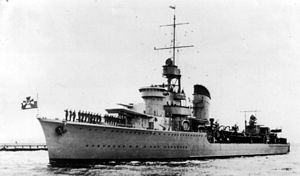- ORP Grom (1936)
-

ORP GromCareer (Poland) 
Name: ORP Grom Namesake: thunderclap Laid down: 17 July 1935 Launched: 20 July 1936 Commissioned: 11 May 1937 Decommissioned: 4 May 1940 Fate: Sunk in the fjord Rombaken near Narvik in Norway General characteristics Displacement: 1,975 tons standard
2,183 tons normal
2,400 tons fullLength: 114 m (374 ft) Beam: 11.3 m (37 ft 1 in) Draft: 3.3 m (10 ft 10 in) Propulsion: Two Parsons' steam turbines of 54,000 shp (40,000 kW) altogether, 3 boilers and 2 shafts Speed: 39 knots (72 km/h/45 mph) Range: 3,500 nautical miles (6,500 km/4,000 mi) at 15 knots (28 km/h/17 mph) Complement: 192 Armament: 7 × 120 mm (4.7 in) Bofors wz. 34/36 guns
2 × double 40 mm (1.6 in) AA Bofors guns
4 × double 13,2 mm AA Hotchkiss HMG
6 × 550 mm (22 in)/533 mm (21.0 in) torpedo tubes
2 × depth charge launchers, 20 wz. BH 200 bombs
44 naval minesORP Grom was the lead ship of her class of destroyers serving in the Polish Navy during World War II. She was named after the Polish word for "thunderclap".
History
Grom was ordered from the British J. Samuel White shipyard in Cowes and laid down in 1935, and commissioned in 1937. Grom was thought of as a large destroyer, similar to flotilla leaders. She and sister ship Błyskawica were to support the outdated French-built Wicher and Burza in the role of the core of the Polish Navy in a possible conflict. As Poland had only one major seaport, the main task of the Polish naval forces was to secure supplies shipment to and from the allied countries. Because of that, the Grom-class was designed to fulfil both the role of shore defence and convoy escort and was supposed to be stronger than single enemy destroyers. Two Parsons' steam turbines of 54,000 shaft horsepower (40,000 kW) altogether, 3 boilers and 2 shafts allowed the Grom to travel at 39 knots (72 km/h/45 mph), faster than the contemporary designs like the U.S. Farragut and Porter classes, the British Tribal class, or the German Type 1934 class destroyers. Also, as it was not clear whether the ships would be used to secure convoys to the Polish port of Gdynia or the Romanian port of Constanţa, the possible range was much larger than in the case of destroyers designed exclusively for the Baltic Sea. The ship had an effective range of 3,500 nautical miles (6,500 km; 4,000 mi) at 15 knots (28 km/h/17 mph).
On 30 August 1939, the Polish destroyers Burza, Błyskawica and Grom were ordered to activate the Peking Plan, and the warships headed for Great Britain, from where they were to operate as convoy escorts. On 1 September 1939, Polish destroyers met the British destroyers Leith, and in the night the Polish destroyers came to Rosyth. However, no convoys were ever organized to help Poland during the Polish Defensive War and the Polish ships were used in support of allied maritime operations.
During her operations during the Norwegian Campaign Grom was ranked by the German soldiers as probably the most hated of all the allied ships deployed to the area[1]. This hatred was founded by the fact that the Grom took an intense interest in all hostile movements on shore and was reputed to spend hours lurking the coast in order to kill even a single German. On 4 May 1940, Grom carried out what turned out to be the last of her many Naval Gunfire Support missions in the Narvik area in the Rombaken fjord. Her loaded midship torpedo launcher was struck by a bomb from a German plane and the torpedo exploded, causing the hull to break into two parts and the ship to sink almost immediately with a loss of life of 59 sailors.
The wreck was never raised and it was not until 6 October 1986 that it was penetrated by divers for the first time.[citation needed]
See also
Notes
Grom-class destroyer Grom · Błyskawica
Preceded by: Wicher class · Followed by: Improved Grom class
List of ships of the Polish NavyCategories:- Grom class destroyers
- World War II destroyers of Poland
- World War II shipwrecks in the Norwegian Sea
- 1936 ships
- Maritime incidents in 1940
- Ships sunk by aircraft
Wikimedia Foundation. 2010.
